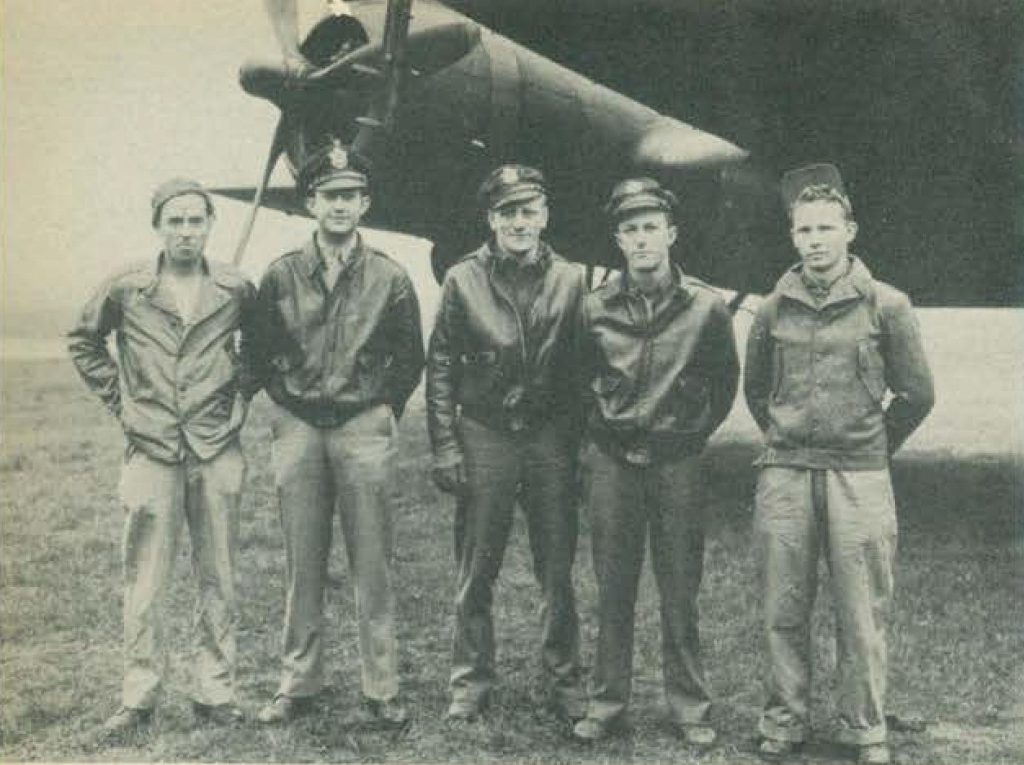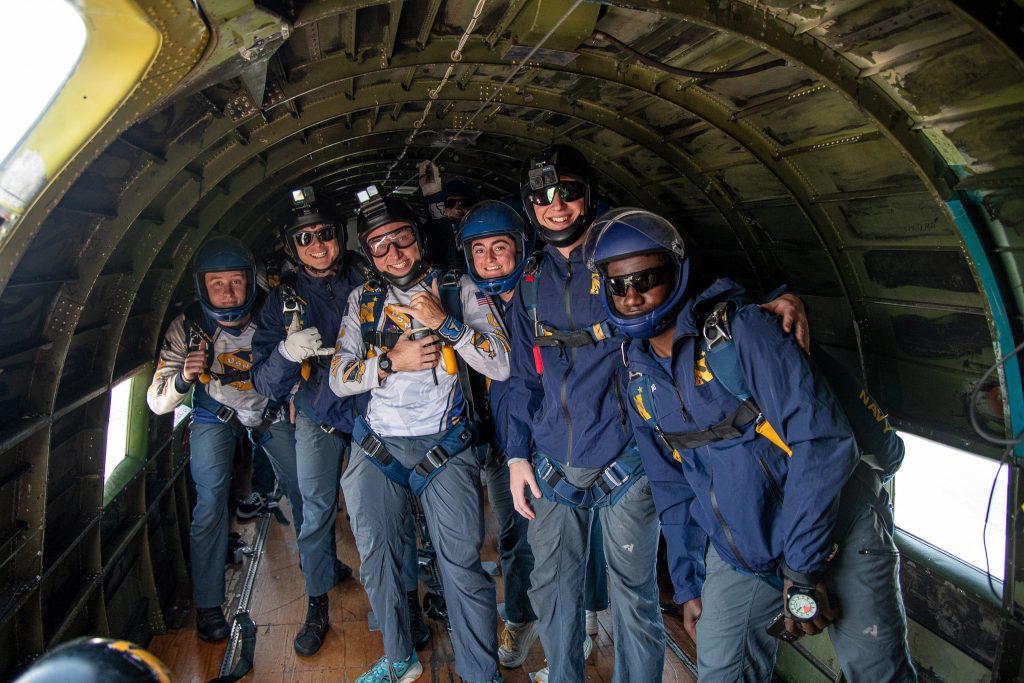It is often said that warbirds bring people together who might not have otherwise met and that they connect the ghosts of the past with those of us in the present. Such an interaction took place on October 12, 2024, at Easton Airport/Newnam Field (ESN) on Maryland’s Eastern Shore during the 14th Annual Easton Airport Day. Airshows across the country typically open with a skydiving demonstration and this event was no different, at least from the outside. In the air however, it was anything but typical because the jump plane was one of the most historic C-47s flying today, the Tunison Foundation’s C-47A USAAF #42-24064 Placid Lassie, a combat veteran of Operations Overlord, Market Garden, Repulse, and Varsity, and the young men and women that went out her door were the future leaders of America’s naval forces and current members of the United States Naval Academy Parachute Team.

When Placid Lassie rolled off the Douglas Aircraft Company in Long Beach, California in July 1943, she was known only by her serial number. The following month she was assigned to the 74th Troop Carrier Squadron (TCS), 434th Troop Carrier Group (TCG), in Alliance, Nebraska. It was here she met her crew: 1st Lieutenant (Lt) Richard H. Lum (Pilot), 1stLt Ralph C. Lundgren (Co-Pilot), 1st Lt William E. Vaughan (Navigator), Staff Sergeant, Ed Tunison (Radio Operator), and Technical Sergeant Eddie A. Apodaca (Crew Chief). Not only did they name her Placid Lassie, but they also named her engines; Idling Ada (L) for Apodaca’s wife and Eager Eileen (R) for Tunison’s. Shortly after D-Day, Lundgren became the captain of his own C-47 and was replaced by 1st Lt. Merton Eckert. The remainder of the crew remained with Lassie throughout the war.

On the morning of June 6, 1944, Lassie and the rest of the 74th TCS took off for Normandy at 0200 hours. In total, they carried 155 members of the 101st Airborne Division and equipment in assault gliders. Two hours they released their gliders and returned to England, but their day was not over. Lassie and her crew returned to Normandy at 2100 hours towing another glider. Radio Operator Ed Tunison remembered that the sky was full of aircraft, in contrast to the relative silence of morning. In the days following D-Day, Lassie flew resupply missions into France in support of the 101st Airborne and later provided logistical support and evacuation services throughout the Battle of Normandy. By September 1944, however, airborne support was needed to secure key bridges in the liberation of the Netherlands, a mission that became Operation Market Garden. Over the course of four days, Placid Lassie and the 74th TCS flew four missions, a combination of parachute drops and glider missions, making a key contribution to freedom in Holland.
By Christmas 1944, Allied forces had continued to advance across Europe, but the 101st Airborne was encircled by German forces at Bastogne, during the Battle of the Bulge. The paratroopers of the Screamin’ Eagles were in dire need of resupply, but weather grounded all aircraft for days. When the weather cleared, the Allies launched Operation Repulse, and the 74th TCS, include Lassie, made three vital supply drops between December 23 & 26. These supplies allowed the 101st to break out and finally push the Germans back. During Operation Varsity, the first crossing of the Rhine, in March 1945 the 74th dropped paratroopers of the 17th Airborne Division in Wesel, Germany. Even today, Varsity remains the largest airborne operation to ever take place in a single day over a single location. After Varsity, the 74th remained busy, delivering cargo to advancing troops and evacuating casualties, sometimes landing just four miles behind the front lines.
After the war, Lassie returned to the U.S. and embarked on a decades-long career of airline and cargo operations up until the turn of the century—sixty years of continuous service. In the late 2000s, when historical research revealed her combat record, particularly on D-Day, then-owner James Lyle had her repainted in D-Day colors in preparation for the 70th anniversary of D-Day in 2014. Amazingly enough, Dutch historian Hans de Brok told the team that Ed Tunison, the wartime radio operator, was still alive and well. Ed was quickly flown to Normandy to reconnect with his airplane, where he told the team that she was known as Placid Lassie during the war.

After returning to the U.S. in the fall of 2014, Lyle continued to operate Placid Lassie for personal and commemorative flying. Shortly after Ed Tunison’s passing in 2016, Lyle and Lassie’s chief pilot, Eric Zipkin, set up the Tunison Foundation, in order to ensure Lassie’s continued preservation and airworthiness. The Foundation began to operate Lassie regularly on the airshow circuit in 2018 and led the D-Day Squadron of fifteen C-47s that returned to Normandy for the 75th anniversary of D-Day in 2019. In October 2022, the Foundation found a permanent home for Lassie in Poughkeepsie, New York. In 2024, the team returned to Europe for the third time to commemorate the 80th anniversary of D-Day and the 75th anniversary of the Berlin Airlift as a part of the D-Day Squadron Legacy Tour. Beyond 2024, it’s the Foundation’s goal to keep operating Placid Lassie to educate future generations for as long as possible.
The United States Naval Academy Parachute Team was founded in 2003 as a recreational club but has since progressed into a team of competition and demonstration skydivers that focus on representing the Naval Academy in front of the public. The mission of the team is to prepare future Naval Officers for the unique challenges of leadership in dynamic environments while building a strong foundation for personal and professional development and growth.

On that crisp, cool morning on October 12th, the author reported to the aircraft and introduced to the flight crew and to Lassie herself with a tour of the cockpit. At the time, this was supposed to be an enjoyable flight, my first in a C-47, to capture photographs the Midshipmen (Mids) as they exited the aircraft. After gathering the flight crew, the Mids, and their coach posed for the customary group photo with the aircraft, I stood by the tail to film the Mids as they climbed aboard. As I did, I suddenly realized that the scene before me resembled those grainy black & white films we’ve all seen of paratroopers climbing into a C-47 on the eve of D-Day. What’s more, they were all around the same age as the paratroopers who jumped into the Normandy darkness on that Night of Nights and into the teeth of withering ground fire over Holland four months later.
As we strapped ourselves to the floor and awaited engine start, I asked the group if they had ever jumped from a C-47 before and they said no. They said the team had jumped from helicopters, Caravans, Skyvans, and C-130s, but never had they jumped from an aircraft as unique and historic as Placid Lassie. As we taxied to the active, their faces were alive with excitement. They looked around the aircraft, marveling at the patina inside the aircraft and pointing at the signatures of veterans who’d signed the aircraft.
In a world where the younger generations, Gen Z in the case of these Mids, are criticized for their laziness, apathy, and general lack of regard for history, it was encouraging to see these young men and women grasping the fact that this was a special moment. For me, the moment was very moving. As we climbed for altitude, I looked at the open paratrooper door and then at the faces of these young, excitable skydivers, who were of course jumping for the thrill of the sport of skydiving, but they understood that Placid Lassie represented sacrifice of the Greatest Generation, who made the freedom they enjoy possible.
Once we reached jump altitude, a relatively low 1,800ft, it was time for the Mids to get down to business. After a pass to check for wind, pilots Will Milton and Garrett Fleishman, brought Lassie around for the first live pass over the drop zone where team coach, Matt Cecala, sent three skydivers out the door. Each one’s exit was accompanied by a “whump” of air. On the second pass, five more went out Lassie’s door. Then suddenly, Cecala, told Lassie crew member Bob Creter, “Alright, that’s it for the jumps.” The wind wouldn’t allow for him and the sixteen remaining skydivers make the jump. When Cecala told the others to strap back in for landing, the energy was sucked right out of the aircraft. The disappointment on their faces was evident. I was disappointed for them.
Once on the ground, the mood had lightened a little. I told them how sorry I was that they did not get to jump, but they took it in stride, with one telling me, “It’s part of the sport.” As they slowly exited the aircraft, they again looked around the cabin and at the signatures, almost in reverence, and I knew that a warbird had once again done what they do best—connected the past with the present. The ghosts of the men who flew aboard Placid Lassie in the war-torn skies of Western Europe reached across four generations and left a lasting impression on those who will carry on their legacy of defending freedom.





































